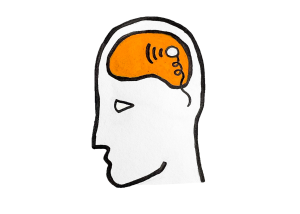Professor part of brain health treatment study

Dr. McHardy’s team is developing novel small molecules to suppress tumor growth in patients with GMB.
February 7, 2023
Glioblastoma multiforme (GBM) is an aggressive, fast-growing brain cancer with a high mortality rate. Most patients do not live more than one year after their diagnosis, and only 12% live for five years.
A team of scientists from UTSA and UT Health San Antonio is working to find a viable treatment option for GBM patients. Their research aims to develop a compound to reduce GBM tumor size, thereby decreasing the symptoms patients may experience and adding another treatment modality to existing cancer therapies.
Dr. Stanton McHardy, a chemistry professor at UTSA, became involved with the project due to two of his collaborators — Ratna K. Valdlamudi, a professor in the OB-GYN department at UT Health San Antonio, and Andrew Brenner, M.D., Ph.D., from the Mays Cancer Center.
“They came to me and talked to me about this program, and it was perfect for me because it combined two of the things that I am passionate about — neuroscience research and cancer,” McHardy said.
Most of McHardy’s time is consumed by research dedicated to developing pre-clinical drug candidates as the Center for Innovative Drug Discovery (CIDD) director. The CIDD is funded by the Cancer Prevention Research Institute of Texas (CPRIT); grant’s from the institute have allowed the generation of preliminary data on fundamental projects at the CIDD and paved the way for funding granted by the National Cancer Institute.
“The team recently was awarded $3 million by the National Cancer Institute (NCI)”, an article from UTSA Today reads. “The grant, which began on January 1, 2023, follows previous NCI funding of $2 million that supported laboratory studies yielding fundamental understandings needed to progress to drug development.”
A primary focus of McHardy’s research is on “developing novel small molecules for therapies.”
“We think of ourselves as molecular architects,” McHardy said. “So, the heart and soul of what we do is designing new molecules for improved biological activity.”
McHardy explains that it is “an incredibly large challenge to develop a small molecule that could kill the GBM tumor because in order to kill the GBM tumor, it has to get past the blood-brain barrier.”
The blood-brain barrier is a crucial part of the CNS. It surrounds the brain, protecting it from harmful substances. The barrier is like a gated neighborhood; it only lets in the residents who keep the community running while preventing unwanted guests that could disrupt their environment.
As molecular architects, the researchers at UTSA are using pharmacokinetics — how a drug or molecule moves throughout the body — to manipulate these small molecules to have the best possible blood-brain barrier penetration.
The biological target of these small molecules is estrogen receptor-beta, shown to be a tumor suppressor that McHardy believes is a “valuable target to go after for GBM.”
“We have in vivo data [research done within a living organism] to show that if you have a xenograft model — taking a human GBM tumor and growing it in a muscle of an animal — and then treating that animal with the developed drug, we can decrease that tumor size and knock down the tumor,” McHardy said.
All the in vivo data is collected at UT Health San Antonio by the Department of Obstetrics and Gynecology and the Mays Cancer Center using the small molecules developed in McHardy’s lab. This project is a prominent multidisciplinary collaboration and is only possible for McHardy and his team with the help of the UT Health San Antonio research partners.
“We do all the compound design, we make the compounds and we analyze the data, the structure, the activity. But we could not do this without our other partners; this is really and truly a cross-institutional, multidisciplinary collaboration; you don’t see that all the time in academics,” McHardy said.
In April, the CIDD is hosting its fifth Annual Drug Discovery Symposium, for which registration is open. For more information on the drug symposium, visit https://research.utsa.edu/events/2023/04/03-cidd-annual-drug-discovery-symposium.html. For additional information on the CIDD and GBM research, visit https://cidd.uthscsa.edu/.








